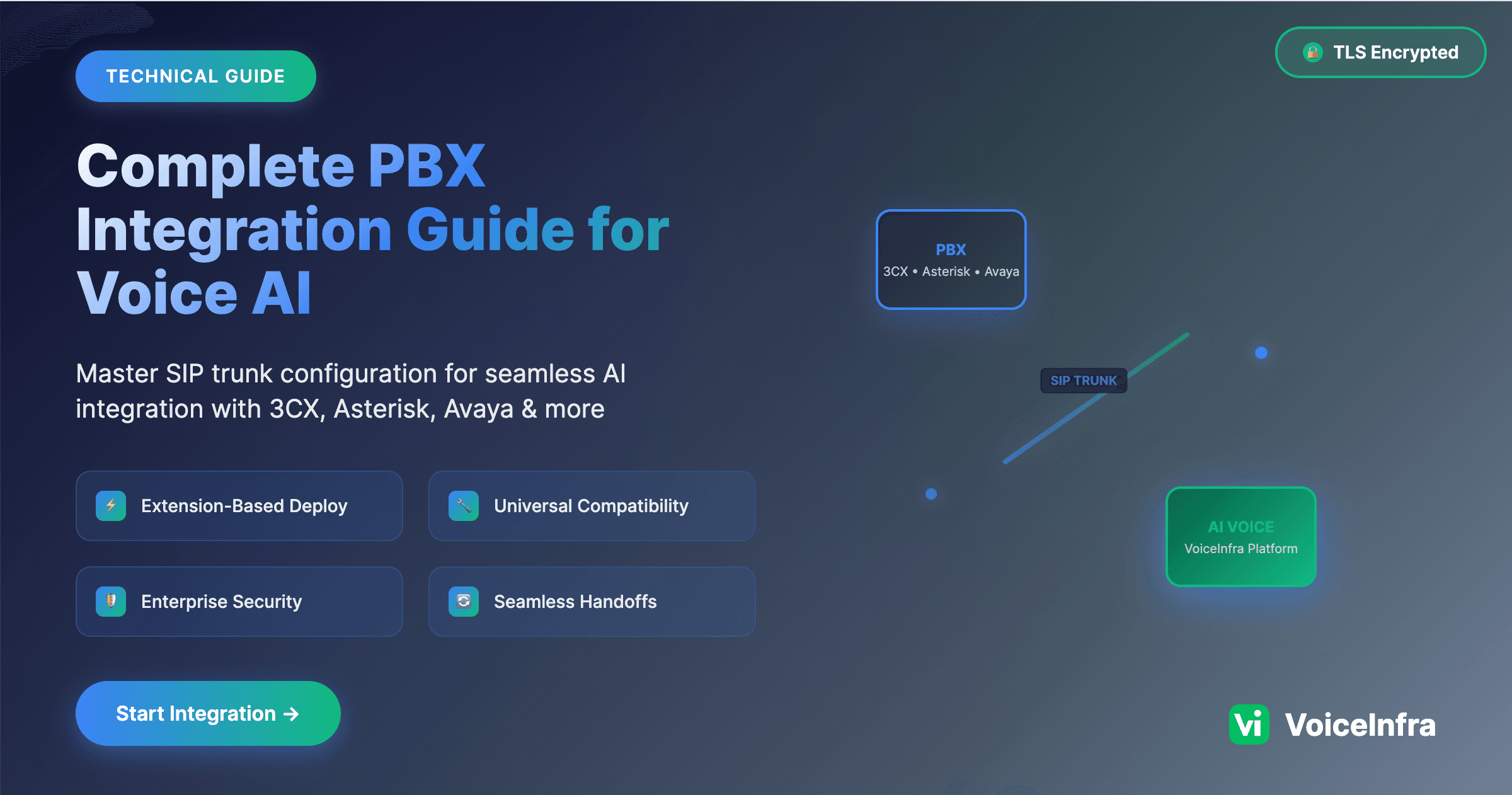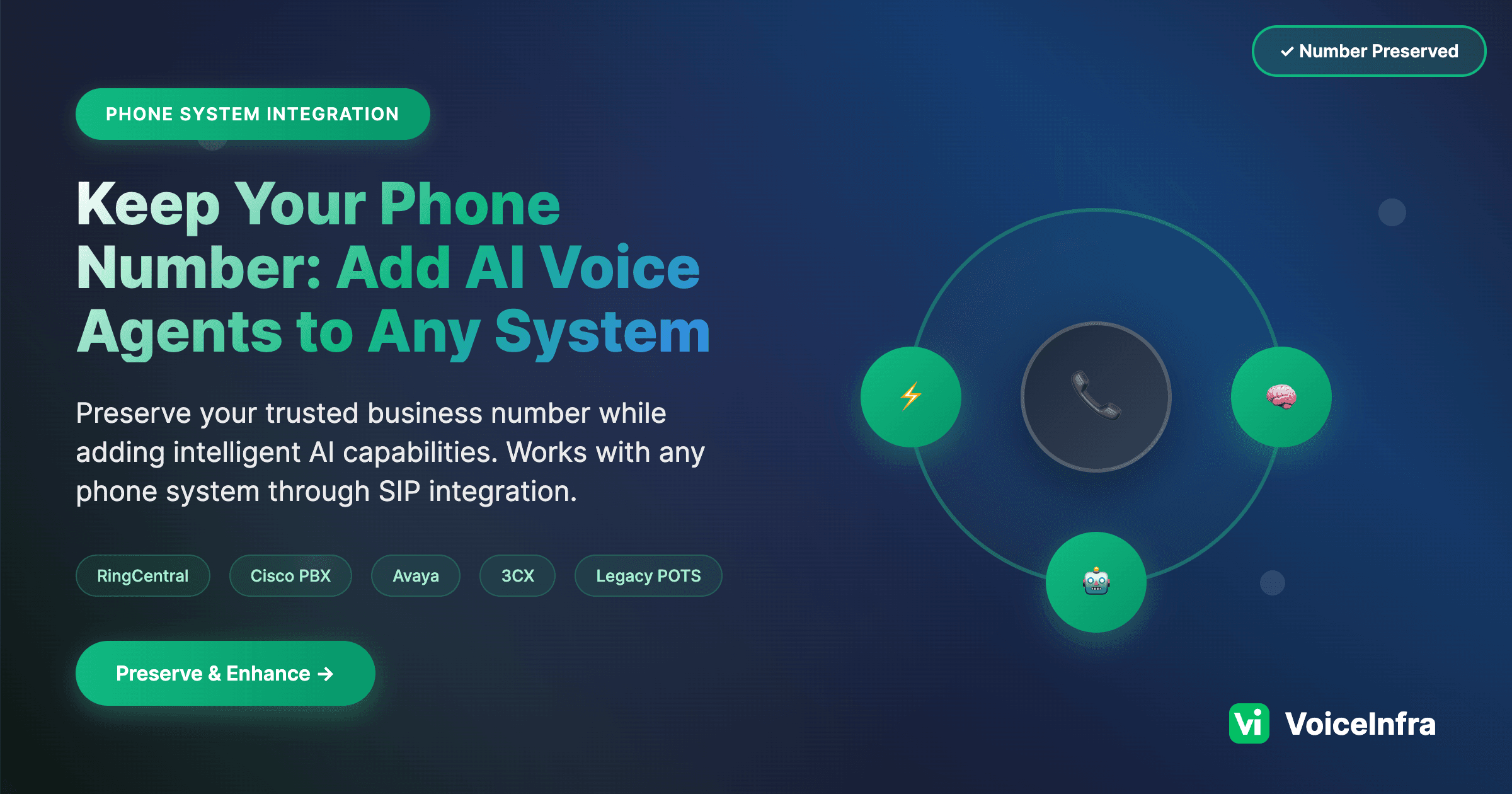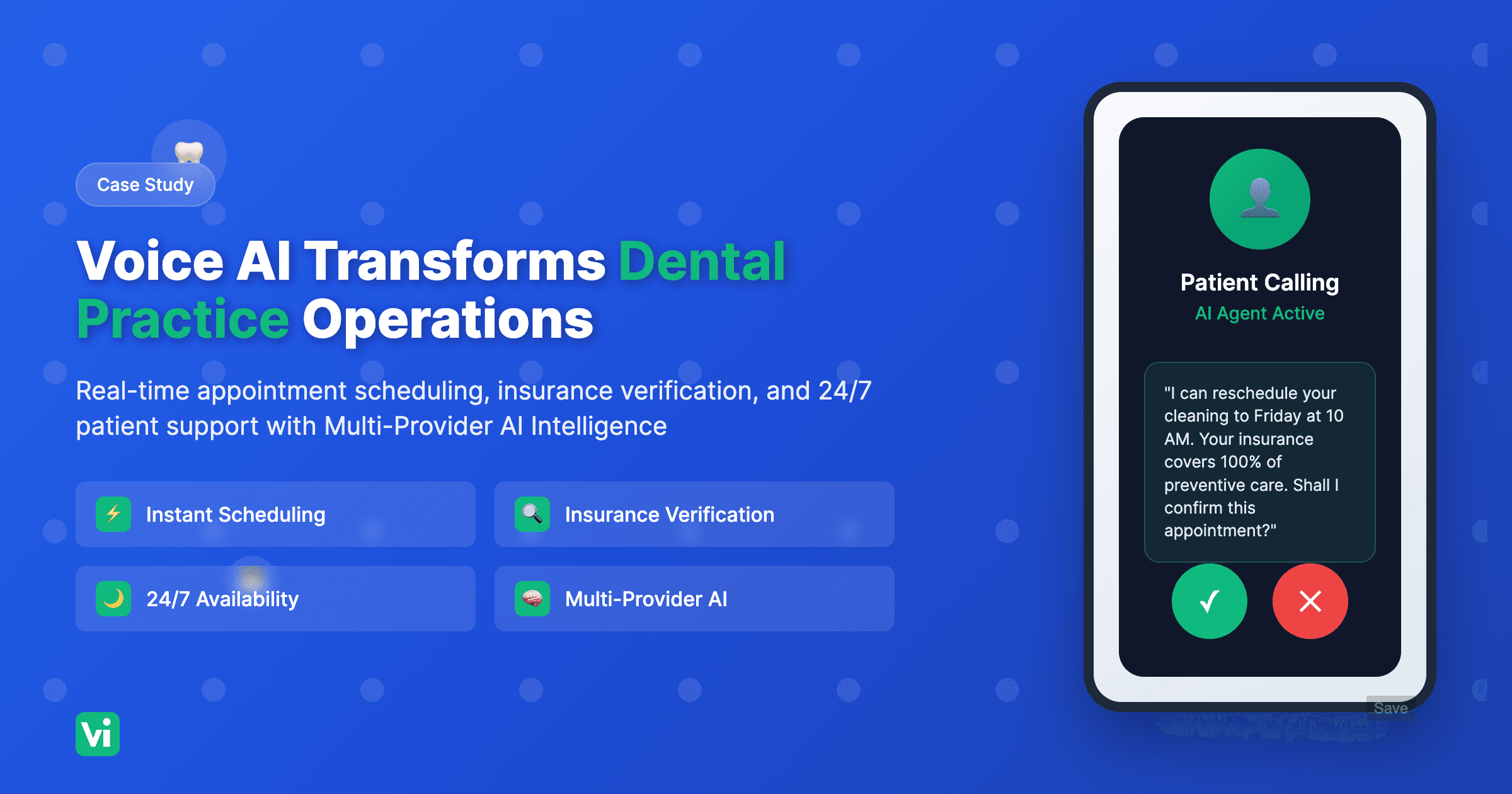Your business phone system is the backbone of customer communication. But in 2025, customers expect AI-powered conversations, not endless phone trees and hold music.
The challenge? Most businesses assume they need to replace their entire PBX infrastructure to add voice AI capabilities. That's simply not true.
With proper SIP trunk configuration, you can integrate advanced voice AI platforms, such as VoiceInfra, directly into your existing phone system, whether you're running 3CX, Asterisk, Avaya, Yeastar, or FreePBX.
This comprehensive guide walks you through everything you need to know about PBX integration for voice AI platforms, from basic SIP trunk setup to advanced security configurations.
Why SIP-Enabled PBX Integration Matters for Voice AI
The Business Case for PBX Integration
Traditional Approach: Replace your entire phone system → Months of downtime → Massive costs → Staff retraining
Smart Approach: Integrate voice AI through SIP trunks → Deploy in hours → Keep existing infrastructure → Immediate ROI
What SIP Integration Enables
Preserve Your Investment - Keep your existing PBX, phone numbers, and infrastructure
Instant AI Capabilities - Add voice AI agents without hardware changes
Seamless Handoffs - Transfer calls between AI and human agents with full context
Extension-Based Deployment - Deploy AI agents on specific extensions
Unified Management - Control everything through your existing PBX interface
Understanding SIP Trunks: The Bridge Between PBX and Voice AI
What is a SIP Trunk?
Session Initiation Protocol (SIP) trunks are virtual connections that enable voice communication over IP networks. Think of them as digital phone lines that connect your PBX to external services, including voice AI platforms.
How SIP Trunks Enable Voice AI Integration
Inbound Calls:
Customer calls your business number
Call routes through your PBX
PBX forwards the call to the voice AI platform via SIP trunk
AI agent handles the conversation
Complex issues escalate back to human agents
Outbound Calls:
Voice AI platform initiates a call via SIP trunk
Call routes through your PBX
Uses your business caller ID
Maintains call logs in your existing system
Step-by-Step PBX Integration Guide
Phase 1: Pre-Integration Planning
1. Assess Your Current PBX System
Document your PBX model and version
Identify available SIP trunk capacity
Review current call routing rules
Check firewall and network configuration
2. Choose Your Integration Method
Extension-Based: Assign AI agents to specific extensions
Number-Based: Route-specific phone numbers to AI
Hybrid: Combine both approaches for maximum flexibility
3. Plan Your Call Flow
Map the customer journey from initial call to resolution
Define escalation triggers for human handoff
Design fallback procedures for system failures
Phase 2: SIP Trunk Configuration on Your PBX
For 3CX Systems:
Navigate to SIP Trunks
Open 3CX Management Console
Go to "Trunks" → "Add SIP Trunk"
Configure Basic Settings
Trunk Name: VoiceInfra-AI-Agent Main Trunk Number: [Your AI-designated number] Registrar/Server: [Voice AI platform SIP endpoint]Set Authentication
Choose between IP-based or registration-based auth
Enter the credentials provided by your voice AI platform
For Asterisk Systems:
Edit sip.conf
[voiceinfra-trunk] type=peer host=[Voice AI platform IP] username=[Your username] secret=[Your password] context=from-voiceinfraConfigure extensions.conf
[from-voiceinfra] exten => _X.,1,Dial(SIP/voiceinfra-trunk/${EXTEN})
For Avaya Systems:
Access System Manager
Navigate to "Routing" → "SIP Trunking"
Create a new SIP trunk group
Configure Trunk Parameters
Set signaling group and trunk group
Define codec preferences (G.711, G.722)
Configure security settings
Phase 3: Voice AI Platform Configuration
Using VoiceInfra as an example, here's how to configure the platform side:
1. Basic Information
Enter your phone number in E.164 format (+1234567890) or Extension number with SIP domain (e.g., 1001@pbx.company.com)
Assign a descriptive name for easy identification
2. Inbound Configuration
Choose your inbound trunk type:
a) Minimal Inbound Trunk
Accepts all inbound calls to the number
Simplest configuration for basic setups
Best for: Single-purpose AI agents
b) Phone Numbers and IPs Specific
Restricts calls to specific caller numbers and IP ranges
Enhanced security through allowlisting
Example: Accept calls from +11111111, +22222222, and IP range 1.1.1.0/24
Best for: Controlled environments with known callers
c) Auth/Pass Protected
Requires username/password authentication
Highest security level
Integrates with SIP trunk provider credentials
Best for: Enterprise deployments
3. Outbound Configuration
Configure these essential parameters:
Outbound SIP URI: Your PBX's SIP endpoint
Outbound Auth Username: SIP authentication username
Outbound Auth Password: SIP authentication password
SIP Transport Protocol: Choose from TCP, UDP, TLS, or AUTO
TCP: Reliable, standard choice
UDP: Faster, less overhead
TLS: Encrypted, most secure
AUTO: Platform selects optimal protocol
Security Best Practices for PBX-Voice AI Integration
Network Security
1. Firewall Configuration
Inbound Rules:
- Allow SIP signaling: Port 5060 (TCP/UDP) or 5061 (TLS)
- Allow RTP media: Ports 10000-60000 (UDP)
- Restrict source IPs to voice AI platform rangesOutbound Rules:
- Allow SIP registration to voice AI platform
- Allow DNS resolution for SIP endpoints
2. Transport Layer Security
Always use TLS for SIP signaling in production
Enable SRTP for media encryption
Verify SSL certificates for voice AI platform endpoints
3. Authentication Methods
Digest Authentication: Username/password (recommended)
IP-based Authentication: Allowlist approach (less secure)
Certificate-based: Highest security for enterprise
PBX Security Hardening
1. Access Control
Limit SIP trunk access to specific extensions
Implement time-based routing restrictions
Monitor unusual call patterns
2. Call Routing Security
Prevent toll fraud through proper dial plans
Implement least-privilege routing rules
Regular audit of trunk permissions
Advanced Configuration Options
Custom SIP Headers
Add provider-specific headers for enhanced functionality:
lang:bash X-CALL-ID: Unique call identifier X-CALLER-ID: Customer identification X-CAMPAIGN-ID: Marketing campaign tracking X-PRIORITY: Call priority level
Codec Optimization
Recommended Codec Priority:
G.722: High-quality 16kHz audio
G.711 (PCMU/PCMA): Standard 8kHz audio
G.729: Compressed audio for bandwidth-limited environments
Load Balancing and Failover
Multiple SIP Endpoints:
lang:bash Primary: sip1.voiceinfra.ai Secondary: sip2.voiceinfra.ai Tertiary: sip3.voiceinfra.ai
Failover Configuration:
Set trunk priorities in your PBX
Configure automatic failover timers
Implement health checks for endpoint monitoring
Troubleshooting Common Integration Issues
Connection Problems
Symptom: Calls not connecting to the voice AI platform
Solutions:
Verify SIP endpoint configuration
Check firewall rules for SIP ports
Confirm DNS resolution of the voice AI platform
Test with different transport protocols
Authentication Failures
Symptom: SIP registration failures or 401/403 errors
Solutions:
Double-check username/password credentials
Verify IP allowlisting on the voice AI platform
Check for special characters in passwords
Confirm authentication method compatibility
Audio Quality Issues
Symptom: Poor audio quality, one-way audio, or no audio
Solutions:
Verify RTP port ranges in the firewall
Check for NAT/firewall traversal issues
Test different codecs
Monitor network bandwidth and latency
Call Routing Problems
Symptom: Calls are not routing correctly between the PBX and AI
Solutions:
Review dial plan configuration
Check extension mapping
Verify trunk group assignments
Test with simplified routing rules
Platform-Specific Integration Guides
3CX Integration
Advantages:
Built-in SIP trunk templates
Web-based management interface
Excellent documentation and support
Best Practices:
Use 3CX's trunk templates when available
Configure separate trunk groups for AI vs. human agents
Leverage 3CX's call flow designer for complex routing
Asterisk Integration
Advantages:
Maximum flexibility and customization
Open-source with extensive community support
Powerful dial plan capabilities
Best Practices:
Use separate contexts for AI agent calls
Implement comprehensive logging for troubleshooting
Regular backup of configuration files
Avaya Integration
Advantages:
Enterprise-grade reliability and features
Advanced call routing capabilities
Comprehensive monitoring and reporting
Best Practices:
Work with Avaya-certified technicians
Use Avaya's SIP trunk best practices
Implement proper change management procedures
Measuring Success: KPIs for PBX-Voice AI Integration
Technical Metrics
Call Quality:
Mean Opinion Score (MOS) > 4.0
Packet loss < 1%
Jitter < 30ms
Latency < 150ms
System Reliability:
SIP trunk uptime > 99.9%
Call completion rate > 95%
Authentication success rate > 99%
Business Metrics
Operational Efficiency:
Reduction in call transfer rates
Decrease in average handle time
Improvement in first-call resolution
Customer Experience:
Customer satisfaction scores
Call abandonment rates
Net Promoter Score (NPS)
Future-Proofing Your Integration
Emerging Technologies
WebRTC Integration:
Browser-based calling capabilities
Reduced infrastructure requirements
Enhanced mobile support
AI-Powered Analytics:
Real-time conversation analysis
Predictive call routing
Automated quality monitoring
Scalability Planning
Capacity Management:
Monitor concurrent call limits
Plan for peak traffic periods
Implement auto-scaling where possible
Geographic Expansion:
Multi-region voice AI deployment
Local number provisioning
Compliance with regional regulations
Getting Started with VoiceInfra PBX Integration
Ready to transform your phone system with AI-powered conversations?
VoiceInfra makes PBX integration simple:
60-Second Setup - From configuration to first AI conversation
Universal Compatibility - Works with 3CX, Asterisk, Avaya, Yeastar, FreePBX
Extension-Based Deployment - No new phone numbers required
Enterprise Security - TLS encryption and authentication
Seamless Handoffs - AI to human transfers with full context
Start Your Integration Today:
Assessment Call - We'll review your current PBX setup
Custom Configuration - Tailored SIP trunk settings for your system
Guided Setup - Step-by-step implementation support
Go Live - Deploy your first AI agent in under an hour
Schedule Your PBX Integration Consultation →
VoiceInfra's SIP trunk integration works seamlessly with your existing PBX infrastructure, enabling you to add AI voice agents without replacing your current phone system. Our platform supports all major PBX systems, offering enterprise-grade security and reliability.
Frequently Asked Questions About PBX Integration
Can I integrate voice AI with my existing PBX without needing to replace it?
Yes, absolutely. SIP trunk integration allows you to add voice AI capabilities to any SIP-compatible PBX system without hardware changes. You keep your existing phone numbers, infrastructure, and management interfaces while adding AI agents through simple SIP configuration.
Which PBX systems are compatible with voice AI platforms?
Most modern PBX systems support SIP trunking and can integrate with voice AI platforms. Compatible systems include 3CX, Asterisk, Avaya, Yeastar, FreePBX, Cisco, Mitel, and many others. The key requirement is SIP protocol support, which is standard in virtually all IP-PBX systems.
How secure is SIP trunk integration for voice AI?
SIP trunk integration can be highly secure when properly configured. Use TLS encryption for signaling, SRTP for media encryption, and implement proper authentication methods. VoiceInfra supports enterprise-grade security, including digest authentication, IP allowlisting, and encrypted transport protocols.
What's the difference between extension-based and number-based AI deployment?
Extension-based deployment assigns AI agents to specific internal extensions (like ext. 1001), while number-based deployment routes entire phone numbers to AI. Extension-based is ideal for internal workflows and testing, while number-based is more suitable for customer-facing applications. Many businesses use both approaches.
How do I handle calls that need human intervention?
Modern voice AI platforms, such as VoiceInfra, support seamless call transfers with complete context preservation. When the AI determines that human assistance is needed, it can transfer the call to the appropriate agents while providing a full conversation history, ensuring that customers never have to repeat themselves.



